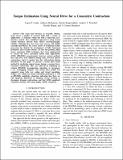Torque Estimation Using Neural Drive for a Concentric Contraction
Author(s)
Leahy, Logan P; Bohannon, Addison; Rangavajhala, Sirisha; Tweedell, Andrew J; Hogan, Neville; Bradford, J Cortney; ... Show more Show less
DownloadAccepted version (727.9Kb)
Open Access Policy
Open Access Policy
Creative Commons Attribution-Noncommercial-Share Alike
Terms of use
Metadata
Show full item recordAbstract
© 2020 IEEE. The scope and relevance of wearable robotics spans across a number of research fields with a variety of applications. A challenge across these research areas is improving user-interface control. One established approach is using neural control interfaces derived from surface electromyography (sEMG). Although there has been some success with sEMG controlled prosthetics, the coarse nature of traditional sEMG processing has limited the development of fully functional prosthetics and wearable robotics. To solve this problem, blind source separation (BSS) techniques have been implemented to extract the user's movement intent from high-density sEMG (HDsEMG) measurements; however, current methods have only been well validated during static, low-level muscle contractions, and it is unclear how they will perform during movement. In this paper we present a neural drive based method for predicting output torque during a constant force, concentric contraction. This was achieved by modifying an existing HDsEMG decomposition algorithm to decompose 1 sec. overlapping windows. The neural drive profile was computed using both rate coding and kernel smoothing. Neither rate coding nor kernel smoothing performed as well as HDsEMG amplitude estimation, indicating that there are still significant limitations in adapting current methods to decompose dynamic contractions, and that sEMG amplitude estimation methods still remain highly reliable estimators.
Date issued
2020Department
Lincoln Laboratory; Massachusetts Institute of Technology. Department of Mechanical EngineeringJournal
Proceedings of the Annual International Conference of the IEEE Engineering in Medicine and Biology Society, EMBS
Publisher
IEEE
Citation
Leahy, Logan P, Bohannon, Addison, Rangavajhala, Sirisha, Tweedell, Andrew J, Hogan, Neville et al. 2020. "Torque Estimation Using Neural Drive for a Concentric Contraction." Proceedings of the Annual International Conference of the IEEE Engineering in Medicine and Biology Society, EMBS, 2020-July.
Version: Author's final manuscript